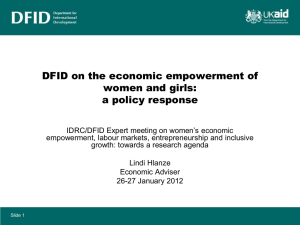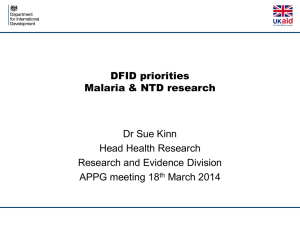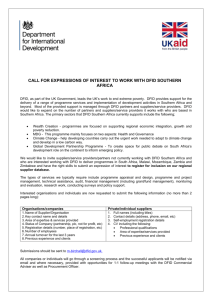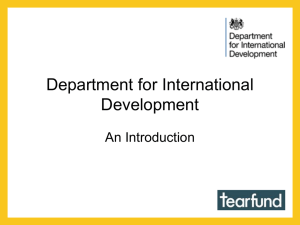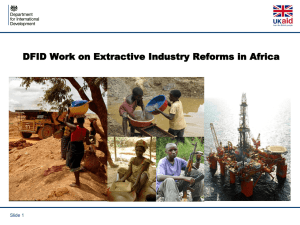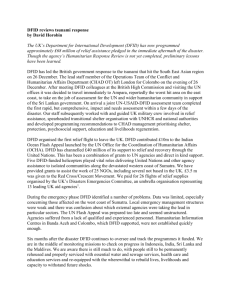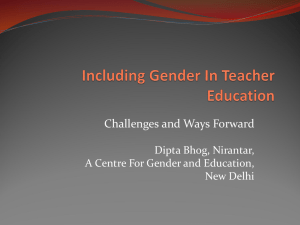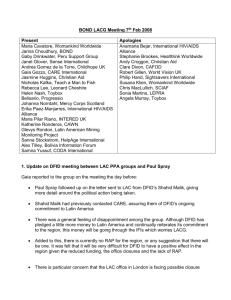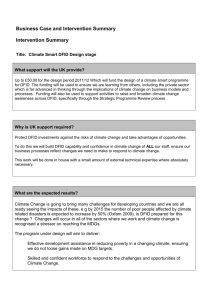Lindi Hlanze, Lead on Economic Empowerment of
advertisement
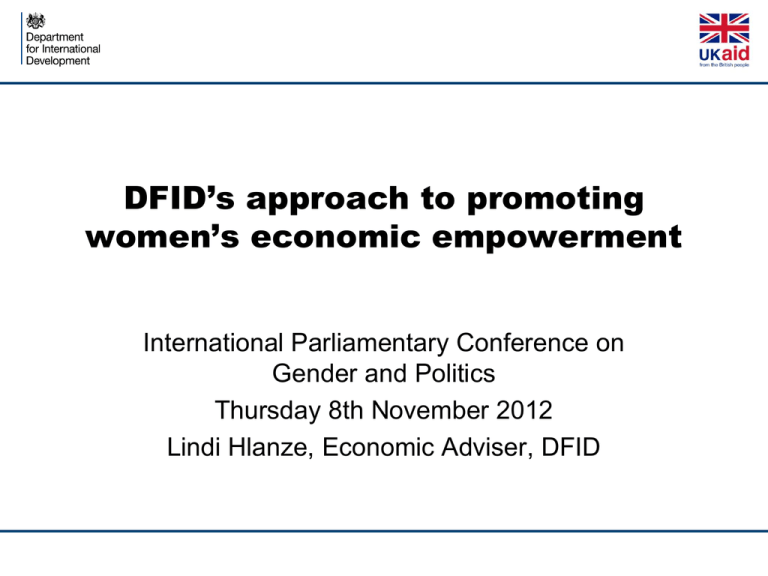
DFID’s approach to promoting women’s economic empowerment International Parliamentary Conference on Gender and Politics Thursday 8th November 2012 Lindi Hlanze, Economic Adviser, DFID Why is women’s economic empowerment important? • It matters for women and girls – contributing to their broader empowerment, agency and voice, and to better welfare outcomes for them, their households and their wider communities. • It also matters for economic growth – for example, through its impacts on firm performance, agricultural productivity and generation of tax revenues. • There are multiple barriers to women accessing resources and opportunities - underinvestment in women’s health and education, discriminatory cultural and social norms and formal or customary laws and regulations, unequal access to resources, knowledge, information, networks and markets, informality and workplace discrimination and exploitation. Slide 2 DFID context DFID’s Business Plan 2011-15: “Recognise the role of women in development and promote gender equality” • One of 6 Ministerial priorities • Critical to delivering the Millennium Development Goals DFID’s working definition of economic empowerment: Economic empowerment is a process that increases people’s access to and control over economic resources and opportunities Slide 3 DFID’s Strategic Vision For Girls And Women Vision Stop poverty before it starts. Transform societies. Mission Invest now in girls and women to multiply our impact. The earlier the better. Delay First Pregnancy and Support Safe Childbirth Economic Assets direct to Girls and Women Get Girls through Secondary School Prevent Violence Against Girls and Women Enabling Environment Build effective legal frameworks to protect girls' and women’s rights + increase the value given to girls and women by society enable women’s participation in politics + sustain political commitment to services and opportunities for girls and women Slide 4 Get economic assets directly to girls and women Access to and control of: 2015 Targets: Financial assets (cash, savings, credit, Improved access to finance for 18 insurance, remittances etc) million women Physical assets (land, property, livestock, productive technologies etc) Secure access to land for 4.5 million Economic empowerment is about more than just assets! Women’s rights and access to human, social and natural capital are critical and complementary. Slide 5 Policy area Programme examples Jobs and livelihoods Nepal Market Development Programme - aims to increase incomes of 150,000 female farmers by up to £80 per year over 5 years Business Innovation Fund - supported Care and Danone’s creation of a rural sales force comprising 2,800 destitute women in Bangladesh (‘Aparajitas’), to increase by 12,000 by 2014 Training and skills Punjab Economic Opportunities Programme (PEOP) - provides market-based skills to 125,000 poor people of which 40% will be women (aims to enhance dairy quality and yields and improve market linkages) Rwanda National Land Tenure Regularisation Roll-Out - support to demarcate, adjudicate and issue title deeds for approximately 6.3m people, 50% of which will be women Global Small and Medium Enterprise (SME) Finance Initiative - will provide finance to over 200,000 SMEs across 15 DFID priority countries, with at least 25% of loans reaching womenheaded SMEs. Benazir Income Support Programme (BISP) - support for 1.1 million female household representatives to receive cash transfers to reduce extreme poverty and hunger, increase access to primary education and contribute to women's economic empowerment Vietnam’s Third Rural Transportation programme - creates employment for ethnic minority women in rural road maintenance and trained 1,533 female rural transportation managers Property rights Financial inclusion Social protection Enabling infrastructure Investment climate (legal and regulatory context) Slide 6 Afghan Climate Investment Facility (AICF) - supporting reforms that will include benefits for women including reducing unnecessary red tape, increasing access to credit, improving land use, strengthening property rights and commercial dispute resolution, strengthening labour market, customs and taxation systems, reducing corruption, and facilitating public private partnerships in infrastructure and agriculture Research and evidence • Private Enterprise Development in Low Income Countries (PEDL) – Centre for Economic Policy Research (CEPR)/DFID research – • Growth and labour markets in developing countries – IZA (Institute for the Study of Labor)/DFID research – • Maximise opportunities for gender-related proposals and gender-disaggregated data particularly under “Dynamics of MSMEs: information & entrepreneurship” theme Gender theme to explore trends, determinants and consequences of female labour participation in LICs, and to identify interventions to support women to enter more productive sectors and increase their earnings potential Country specific examples – – Gender in Nigeria report 2012: www.dfid.gov.uk/Documents/publications1/GenderNigeria2012.pdf Livelihoods, basic services and social protection in Democratic Republic of the Congo: http://www.odi.org.uk/resources/docs/7717.pdf Thank you! Lindi Hlanze Economic Adviser (economic empowerment of women and girls) l-hlanze@dfid.gov.uk Slide 8
